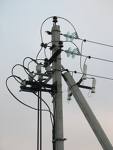Selection of fuses for the protection of overhead lines 0.4 kV
Overhead line fuse protection 0.4 kV
 The protection of overhead lines that are only short-circuit protected must meet the sensitivity requirements. According to PUE the minimum short-circuit current at the end of the protected section must be at least 3 times the rated current of the insert.
The protection of overhead lines that are only short-circuit protected must meet the sensitivity requirements. According to PUE the minimum short-circuit current at the end of the protected section must be at least 3 times the rated current of the insert.
In networks with a grounded neutral (0.4 kV), the sensitivity of fuses is determined for single-phase metallic short circuits between phase and neutral, grounded conductor: Ivs ≤ I (1) kz / 3
In the event of a short circuit between the phase wire and the ground through large transient resistances (dry ground, dry snow, trees, etc.), fuse failures are possible.
It should be borne in mind that in the case of single-phase short circuits, the burning time of the insert can be very long. For example, for PN2 fuses, the burning time of the insert at a triple short-circuit current will be about 15 ... 20 s.
Section fuses
The load adjustment and sensitivity requirements are just the opposite.To meet both requirements, fuses are used in overhead networks, which are additionally installed in the line at a certain distance from the feeder substation. As the load decreases with distance from the supply, the current rating of the fuse may be less than that of a fuse installed at the beginning of the line. As a result, the sensitivity of a sectional fuse to a short circuit at the end of the line will be higher than that of a fuse installed at the beginning of the line. In this way, the network is divided into a number of sections, each of which is protected by its own fuses.
Another important advantage of fuse sectioning should be noted: if any section is damaged, only that section is switched off, the rest of the network remains in service.
